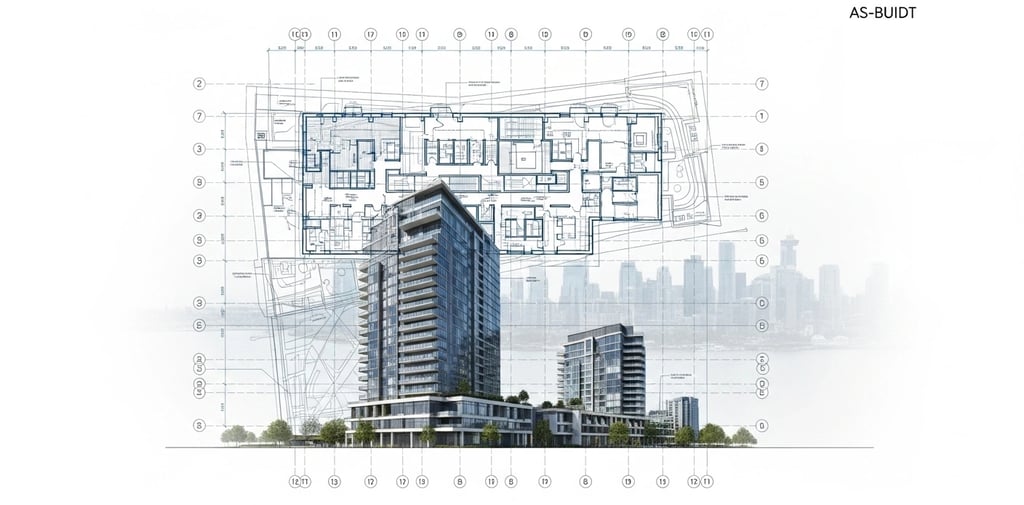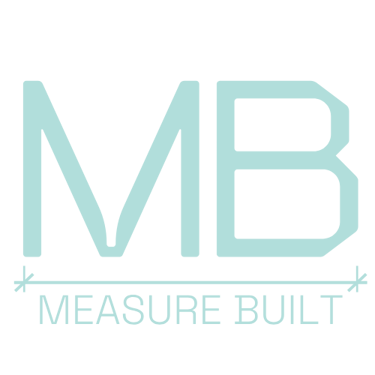As‑built drawings Vancouver: what they are & why you need them
Discover what as‑built drawings Vancouver are, why every Vancouver project needs them, and how they ensure precision, compliance, and cost savings throughout construction and renovation.
AS BUILT DRAWINGS
Emil Jordan
10/6/202512 min read


In the dynamic and competitive real estate and construction environment of the Greater Vancouver Area, precision is paramount. Whether you are a homeowner embarking on a major home renovation Greater Vancouver project, a developer overseeing a large commercial build, or an interior designer crafting a seamless residential space, success hinges on starting with a solid foundation of reliable data. This crucial starting point is provided by as-built drawings Vancouver—detailed documents that capture the reality of an existing structure, exactly as it stands today. These drawings are essential for achieving clarity and confidence in your project, minimizing risks, and ensuring efficient planning and execution throughout the region. Without these precise records, projects inevitably face unexpected challenges that can derail budgets and timelines.
The definitive guide to as-built drawings Vancouver
An as-built drawing, or as-built plan, is fundamentally a final set of drawings that captures all modifications and changes made during construction, depicting the project in its completed state. This set of documents is a detailed representation of the currently constructed structure on a site. Given that projects invariably evolve from the initial design—due to material availability, constructability concerns, value engineering optimizations, or issues found during inspection—as-builts serve as the critical record of the actual executed work.
This comprehensive documentation is necessary for owners to effectively manage, renovate, sell, or even demolish their buildings in the future, as they show the final structure and the location of critical systems. In high-stakes environments like Vancouver, where construction documentation standards are strict, understanding the components and purpose of these drawings is vital.
As-built surveys: the foundation of documentation
Before any final drawings can be drafted, an accurate as-built survey must be conducted. An as-built survey is an on-site process of measuring and documenting the building’s true conditions using precision tools. This survey involves collecting data on the final dimensions, levels, locations, and configurations of elements like walls, utilities, concrete slabs, and roads.
Historically, this was a manual process, but today, advanced technologies yield much more reliable results. The survey’s main purpose is to ensure the project has been implemented according to accuracy and quality standards, allowing for the direct comparison of the constructed elements to the original design.
Red-line markups vs. official as-built drawings
In the construction documentation workflow, the terms "red-line drawings" and "as-built drawings" are sometimes used interchangeably, but there is a technical distinction.
As-built drawings (markups): these are typically created by the contractor during construction, where they mark on-site changes directly onto the original plans, often in red ink. These drawings show what was actually built but may include unverified modifications.
Record drawings: these are generated by architects or design professionals who take the contractor’s as-built markups, review them thoroughly, and compile them into a professionally verified and approved final set of documents. Record drawings are considered more reliable and legally defensible for long-term facility management.
For clarity in the context of professional measurement services in Vancouver, we focus on the final, professionally compiled and dimensionally accurate documents—the accurate floor plans and elevations created from the detailed site measurements, ready for design use.
Key components of comprehensive as-built documentation
A thorough set of as-built drawings Vancouver provides detailed information about both the structure and the critical systems contained within it.
Detailed as-built floor plans typically include:
Room dimensions: exact room sizes, functions, ceiling heights, and changes in elevation (like sill heights and bulkhead dimensions).
Structural elements: the precise locations, dimensions, and orientations of walls, partitions, columns, beams, and door/window locations, including door swing directions.
Openings and fixtures: placement of permanent fixtures, such as plumbing elements (sinks, toilets, bathtubs), kitchen appliances, and, if required, HVAC equipment and electrical components (outlets, panels, switches).
Staircase details: comprehensive stair dimensions, riser heights, treads, and required headroom clearance, along with handrail and guardrail placements showing above-floor heights.
Beyond the architectural layout, comprehensive as-builts must also detail modifications made from the original design, which can range from minor changes like moving an electrical outlet to major alterations in room layouts. These changes are often indicated using revision clouds, delta symbols (Δ), annotations, or revision blocks for easy identification.


Why accurate as-built drawings are non-negotiable in the Greater Vancouver market
In Vancouver’s high-value property market, the decision to invest in precise as-built documentation is a strategic one that saves time, minimizes financial risk, and ensures regulatory adherence.
Compliance and permitting in BC
One of the most immediate and crucial reasons for needing accurate as-built drawings Vancouver is compliance with municipal standards and the BC Building Code.
Ensuring seamless permitting: accurate documentation of existing conditions is designed to meet city requirements, ensuring seamless approval for permitting or renovation projects. Designers rely on as-built drawings that meet city codes and standards to ensure their plans can be approved for permits and executed without delays.
Mandatory documentation: as-built drawings are often contractually binding documents and are necessary for obtaining critical certifications, such as occupancy permits, or for closing permits after construction. Having them ready speeds up approvals and ensures compliance with zoning and accessibility regulations.
Skipping or poorly documenting the as-built phase can lead to costly rework, safety hazards, and failed inspections.
Risk mitigation and financial clarity for all stakeholders
Starting a project with an inaccurate understanding of the existing structure is one of the quickest paths to budget overruns and delays. Accurate as-built documentation provides a reliable baseline that mitigates financial and construction risks.
Reduced rework and change orders: by providing a clear understanding of the space upfront, designers and contractor estimates can avoid unnecessary revisions and costly change orders. Every inaccurate measurement can snowball into wasted materials and schedule slippage.
Avoid costly clashes: detailed architectural drawings help teams avoid clashes with existing structural and architectural elements, preventing expensive changes during implementation. This is critical for seamless integration of new designs.
Future-proofing asset management: as-builts are vital for facility management programs, serving as the reference point for maintenance schedules, system upgrades, and space utilization planning. This detailed record of critical systems—like electrical panels, HVAC, and fire safety elements—allows for informed maintenance decisions, saving time and resources in the long term.
As professional documentation, these drawings are critical for project closeout and can be important for settling insurance or legal issues relating to the building.


The technology driving precision: 3D laser scanning services
The pursuit of millimetre-level accuracy in as-built drawings Vancouver has been revolutionized by technology, moving far beyond the limitations of manual tape measures.
The shift from manual to digital accuracy
For smaller projects, simple tools like tape measures or laser distance meters suffice, but they carry risks of human error and are time-consuming for large areas. For complex commercial properties or large home renovation Greater Vancouver projects, 3D laser scanning services and LiDAR (Light Detection and Ranging) technology are now the industry standard for reliable data collection.
LiDAR scanning: this advanced technology captures detailed, high-resolution 3D data of existing spaces and structures, often collecting millions of data points per second. This depth of detail ensures unmatched accuracy, significantly reducing errors and saving time on site, providing a reliable foundation for any project.
Benefits of 3D scanning: laser scanning ensures precision tools capture measurements correctly the first time, documenting even hard-to-reach spaces. The process is rapid and thorough, collecting large amounts of data in a cost-efficient manner.
Deliverables beyond 2D plans: BIM and point cloud data
The raw data captured by 3D laser scanners—known as a point cloud—is highly versatile and can be converted into advanced digital models, providing essential deliverables for modern architecture and construction.
BIM (Building Information Models): a 3D BIM model (often in Revit or Archicad format) provides an interactive, updated three-dimensional representation of the built structure. This is considered the as-built BIM modeling service or LOD 500 stage in BIM workflows. BIM models incorporate precise spatial data, material specifications, and system integrations, offering an invaluable resource for facility managers and future design teams.
Point cloud data: this raw, high-resolution data set provides a rich source of detail that can be used directly by specialized design software (like Autodesk Revit or AutoCAD) for conversion into the required model. Converting point cloud data to a BIM model is critical for the redevelopment and refurbishment of projects.
Virtual tours: services may also include Matterport virtual tours or 360° panoramic photographs, which offer stakeholders an easily navigable view of the project site, documenting site changes and tracking progress.
These digital outputs enhance workflow, improve collaboration, and ensure that all design concepts align perfectly with the existing spaces.
Essential as-built deliverables for Vancouver projects
A professional as-built firm provides comprehensive deliverables that cover every necessary aspect of a property, ensuring that the documentation serves all stakeholders from interior designers to property managers.
Detailed floor plans: the core of accurate documentation
Accurate floor plans are the most frequently requested and critical components of the as-built package. They are revised horizontal layouts showing the finished arrangement of spaces, detailing exact dimensions and spatial relationships.
For interior designers, these plans are indispensable interior designer tools. They facilitate streamlined space planning with detailed layouts of walls, doors, windows, and fixed elements, allowing designers to effectively plan furniture placement, fixtures, and décor without unexpected surprises during implementation.
Key details included in high-quality accurate floor plans are:
Precise wall locations and thicknesses.
Door and window dimensions, placements, and swing directions.
Ceiling heights and bulkheads.
Fixed plumbing and kitchen appliances.
Elevations, roof, and reflected ceiling plans
Comprehensive documentation extends beyond the horizontal layout to capture vertical and overhead elements:
As-built elevations: these are vertical drawings showing the final appearance of exterior faces (exterior elevations) or interior walls. Exterior elevations depict accurate building facade details, including walls, doors, windows, sill/lintel heights, and architectural features like balconies and cladding materials. They also document overall building heights and key vertical measurements.
Roof plans: these detail the final condition of the roof, including slopes, pitches, overhangs, and features like chimneys, vents, drainage systems, or rooftop equipment (e.g., HVAC units).
Reflected ceiling plans (RCPs): RCPs show the updated layout of elements mounted on the ceiling, such as lighting, sprinkler systems, ventilation, and coordination with architectural ceiling features. These are vital for integrating lighting layouts and ensuring fire safety compliance.
MEP and fire safety documentation
For renovations, particularly in commercial or multi-family residential structures in Vancouver, the locations of Mechanical, Electrical, and Plumbing (MEP) systems are crucial.
As-built MEP & fire safety drawings include:
Mechanical systems: HVAC layout, ductwork, vents, and equipment locations, such as air handling units and exhaust fans.
Electrical systems: placement and routing of electrical panels, outlets, switches, light fixtures, wiring, and conduits where applicable.
Plumbing systems: locations of plumbing fixtures, piping, drainage systems, hot/cold water lines, sewer connections, and vent stacks.
Fire safety systems: placement of fire alarms, extinguishers, emergency exits, and sprinkler head locations/piping.
This incorporation of critical systems allows designers to account for these elements in their plans, ensuring safety, compliance, and functionality.
The stakeholder perspective: tailoring as-builts for success
Different professionals require different levels of detail and specific file formats from as-built drawings Vancouver. A reputable firm provides deliverables tailored to the needs of each role.
For interior designers and architects (interior designer tools)
For design professionals operating in the competitive Vancouver market, accuracy is the starting point for creativity. As-built drawings are fundamental interior designer tools.
Design confidence and clarity: detailed plans minimize risks and maximize efficiency, enabling designers to align new concepts with existing structural elements, avoiding costly surprises. Precise measurements make the design process smoother, ensuring concepts align perfectly with existing spaces.
Streamlined workflow: designers receive comprehensive design assets, including editable DWG files, precise PDFs, high-resolution point cloud data, and intelligent BIM models, enhancing their workflow and collaboration.
Compliance verification: designers rely on as-builts to ensure their plans adhere to city codes and standards for permitting.
As stated by an interior designer specializing in North Vancouver residential projects, having accurate as-built drawings is critical to their work, providing reliability and quick turnaround times.
For contractors and project managers (contractor estimates)
For contractors specializing in home renovation Greater Vancouver or larger construction, precise documentation is synonymous with efficiency.
Accurate planning and estimates: detailed as-builts ensure every project starts on the right foot. They are crucial for preparing reliable contractor estimates, planning logistics, and accurately assessing the scope of work. Accurate plans reduce the risk of errors and prevent unnecessary change orders during construction.
Seamless execution: contractors rely on this information to avoid unnecessary revisions, saving time and reducing costs throughout the project. Comprehensive documentation, including 2D floor plans, elevations, point cloud data, and BIM models, ensures precise planning and seamless execution.
Improved communication: as-built drawings serve as a common, verified reference for contractors, architects, and clients, enhancing collaboration and reducing miscommunication.
One contractor noted that detailed as-built drawings consistently save time and prevent costly mistakes, providing the clarity and confidence needed to move forward efficiently.
For property owners and real estate agents (real estate floor plans)
In Vancouver, whether selling residential or managing commercial portfolios, as-builts add tangible value and credibility.
Elevating property listings: real estate floor plans showcase properties with professional-grade, accurate 2D and 3D layouts, helping potential buyers visualize the space. These visually appealing materials make listings more engaging and appealing in a competitive market.
Leasing and management: building owners and managers require highly detailed drawings for asset and facility management, simplifying record keeping and tenant tracking. Services specializing in BOMA-standard-compliant measurements ensure accurate accounting of leasable areas, which is critical for property management and leasing.
Informed decisions: as-built drawings enable building managers to predict maintenance needs and budgets, leading to more informed purchasing and selling decisions. They reassure potential buyers of the real estate's quality and value, going beyond simple floor plans.


Creating high-quality construction documentation: best practices
The process of creating as-built drawings Vancouver requires a highly skilled team, advanced technology, and rigorous workflows to ensure the final deliverable is 100% accurate and usable.
The professional workflow for accurate as-builts
Top-quality as-built companies follow a structured, proven workflow, transforming on-site conditions into reliable, design-ready documentation.
Planning and site visit: the process begins with defining the scope, followed by an efficient site visit where surveyors capture precise measurements and conditions using fit-for-purpose tools (like LiDAR scanning).
Drafting and modeling: survey data is transformed into detailed CAD, PDF, or BIM files, ensuring the structure is reflected exactly as built. This includes integrating system locations (MEP, fire safety) and architectural features.
Quality assurance (QA/QC): this is a non-negotiable step where all dimensions, annotations, and layer standards are verified to ensure files are accurate, complete, and ready for immediate design use. A structured QA process prevents delivery delays and costly redos.
Delivery: final, approved deliverables are provided to the client in their desired formats, often including scalable CAD (DWG) and PDF files.
Avoiding common mistakes that inflate contractor estimates
Many projects face challenges when documentation is rushed or incomplete. These errors cascade, leading to financial penalties and project stagnation.
To ensure reliable construction documentation, project teams should actively avoid these pitfalls:
Inaccurate measurements: relying on manual measurements instead of precision tools like laser scanning, which can lead to significant construction setbacks.
Incomplete or outdated records: failing to capture construction changes immediately creates a gap between what is built and what is documented.
Failure to verify utilities: missing or mislocating plumbing, electrical, or HVAC lines, which can derail construction and lead to on-site surprises. Complete as-builts must confirm all utility locations.
Poor coordination: confusion between field surveyors and drafting teams, especially when communication guidelines are absent. Using digital tools allows drawings to be shared and reflects changes as they are made.
Late delivery: delays in receiving plans stall projects before they start; efficient workflows are necessary to keep documentation on time.
By continuously updating drawings throughout the life of a project, rather than waiting until the end, accuracy is improved and the final process is made more efficient.
Choosing the right partner for as-built drawings Vancouver
Selecting an experienced and professional as-built firm in the Greater Vancouver Area is critical to ensuring your project starts with the required reliability and accuracy.
Expertise and quality standards
Look for providers with a proven track record, specialization in precise measurement services, and a commitment to industry standards.
BOMA compliance: expertise in providing precise BOMA-standard-compliant measurements is essential for minimizing errors and streamlining commercial planning processes, especially for property managers and real estate professionals.
Professional team: the quality of the final documents relies heavily on the skills and expertise of the surveying professionals and BIM modelers involved. Firms should leverage experienced staff combined with production systems that integrate the latest technology.
Attention to detail: professionalism and attention to detail save time and prevent costly mistakes, providing the clarity and confidence necessary for efficient project execution.
Comprehensive services for all project phases
A dedicated as-built provider should offer a wide array of services tailored to every stage of a project, from pre-construction to post-occupancy facility management. Services should include:
As-built floor plans and elevations.
LiDAR surveying and 3D laser scanning services.
Reflected ceiling plans and roof plans.
Site plans and cross-sections.
MLS real estate floor plans and BOMA leasing plans.
Revit 3D model and point cloud data.
Building permit drawings support.
The ability to deliver files in common, scalable digital formats (CAD, PDF, DWG, BIM/Revit) ensures that the documentation is immediately usable by architects, designers, and contractors.
Fast turnaround and responsive communication
In construction, time is money, especially in commercial projects in Vancouver. A fast turnaround time is a significant advantage.
Speed of delivery: typical timelines can range from a few days to a couple of weeks, depending on complexity. Some services can deliver results as quickly as 48 hours for certain packages.
Responsive support: commitment to responsive communication, often including a pledge to respond to all inquiries within 24 hours, ensures that project timelines are not delayed. Clear milestones and regular progress updates keep clients informed every step of the way.
By partnering with a firm dedicated to efficiency, accuracy, and customer experience, you ensure that your project benefits from a peace-of-mind foundation, ready for successful implementation.
Conclusion: securing project success with as-built drawings Vancouver
The inference is clear: as-built drawings Vancouver are not merely a formality but a foundational strategic investment. For property owners, real estate agents, interior designer tools, and construction professionals navigating the complexities of the Greater Vancouver Area, accurate documentation is essential for:
Minimizing costly rework: accurate records prevent field conditions from triggering expensive change orders, streamlining renovation planning and ensuring reliable contractor estimates.
Achieving compliance: precise documentation meets local city requirements, facilitating the approval of building permit drawings and ensuring adherence to safety and code standards.
Maximizing asset value: providing highly accurate real estate floor plans and comprehensive construction documentation for ongoing maintenance, facility management, and profitable property transactions.
When details matter, starting your project on a solid foundation of precise, verified data is the smartest first step. Leveraging advanced technology like 3D laser scanning services ensures that your accurate floor plans reflect reality, giving you the clarity and confidence to build for a lifetime.
Contact Us
MeasureBuilt
Address
413-8188 Manitoba Street
Vancouver, BC V5X 4L8
Contacts
236-232-3335
emil@measurebuilt.com
When Details Matter!
